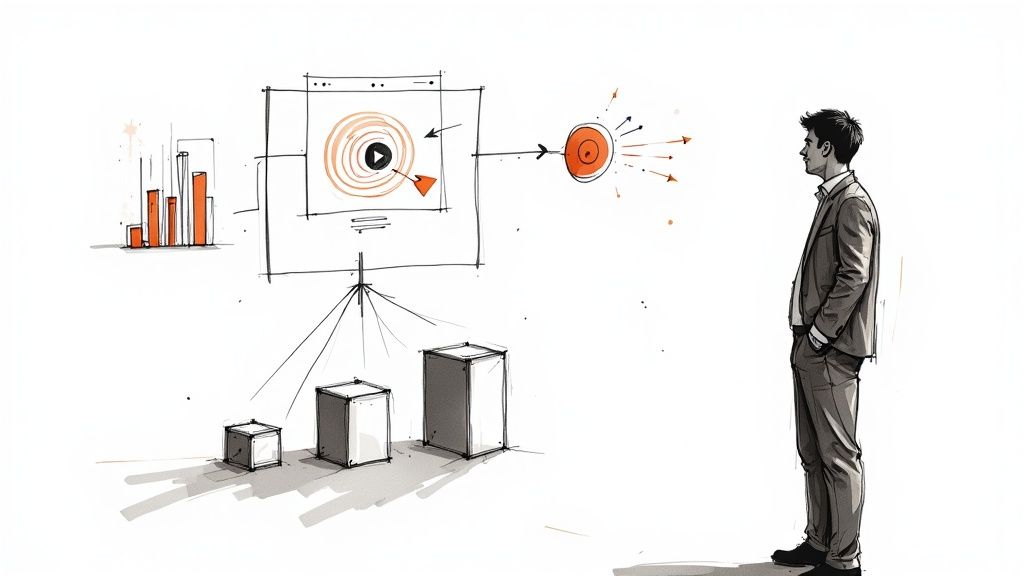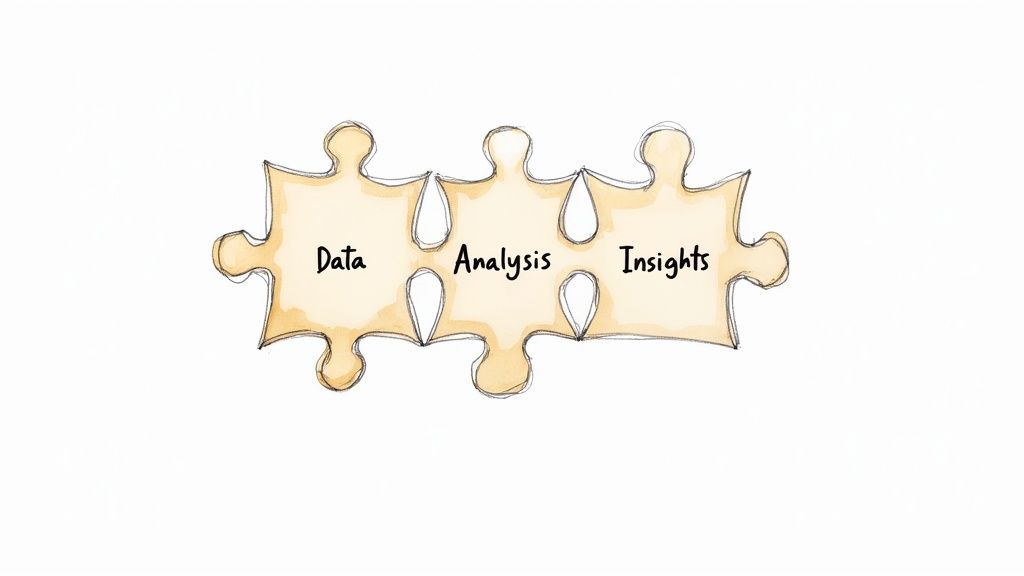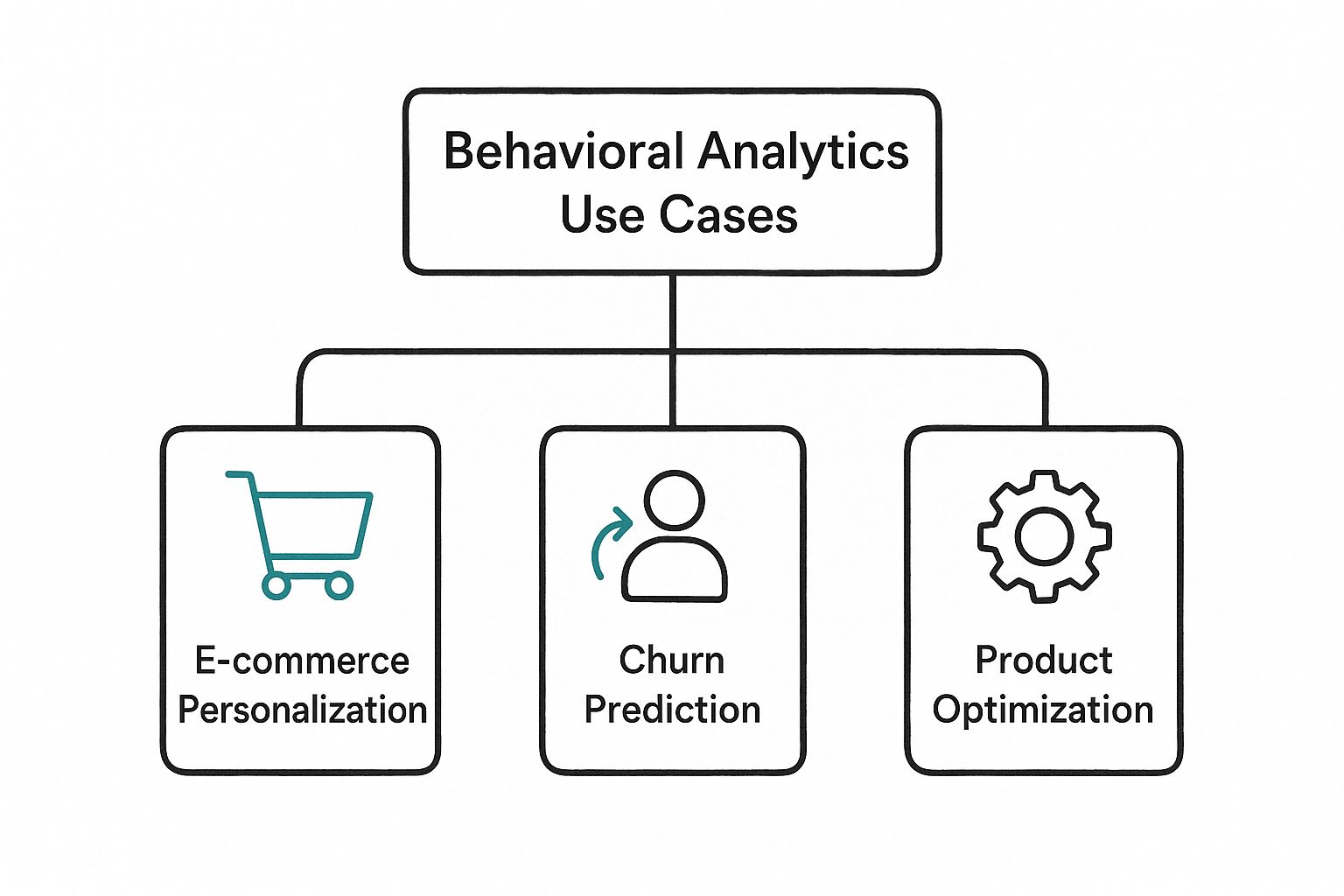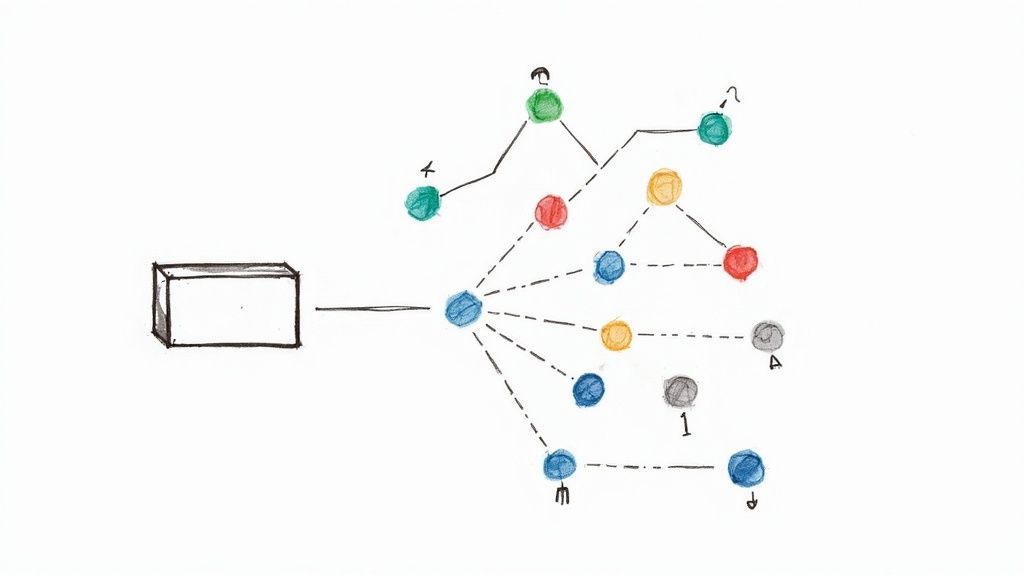
What Is Behavioral Analytics for Corporate Training and Development?
In simple terms, behavioral analytics is the science of understanding why employees do what they do in a digital learning environment. When we talk about corporate training, it's about moving past simple completion rates. It's about uncovering the real story behind how employees interact with training materials so you can build learning and development (L&D) programs that actually work.
Understanding Behavioral Analytics in Corporate Training

Think of old-school training metrics—like course completion rates—as just the final score of a game. It tells you who finished, but gives you zero insight into the plays that actually decided the outcome. You know an employee completed a module, but you have no idea if they struggled, breezed through, or genuinely absorbed the information.
Now, imagine you’re a training manager reviewing the game film. That's the power of behavioral analytics. You get to see every action in context: every pause before answering a question in an interactive video, every confident click through a complex scenario, and every time someone rewound a confusing section. This level of detail elevates your understanding from basic reporting to deep, actionable insight for improving your training content.
Behavioral analytics isn't just about gathering data; it's about linking actions to intent. It answers the crucial "why" behind an employee's learning journey, showing you the moments of confidence, confusion, and genuine engagement.
The Story Behind the Numbers
This shift from the "what" to the "why" is everything for L&D professionals. Instead of getting a simple pass/fail grade for a training module, you get a rich story of the learning experience itself. Did a new salesperson watch the interactive video on handling objections three separate times? That’s not a failure—it's a sign of diligence and a perfect cue for a manager to offer some targeted coaching.
This approach gives learning and development teams the power to stop guessing and start making decisions based on solid data. You can pinpoint exactly where your training content is hitting the mark and where it’s falling flat.
The 5 Ws of Behavioral Analytics in Training
To really get a handle on behavioral analytics, it helps to look at the questions it answers. This simple framework shows how raw data from your training platform turns into meaningful intelligence you can use to improve your corporate development programs.
Here’s a quick breakdown of how it works.
By asking these five questions, you can move beyond surface-level stats and start understanding the human behavior driving them. This is where you find the insights that lead to truly effective training.
Why Behavioral Analytics Matters for Training and Development

The push to understand learner behavior isn't just some passing fad. It’s a direct response to major shifts in the modern workplace. Companies are juggling digital-first tools, remote teams, and constant pressure to prove the ROI of every training initiative.
This has completely flipped the script on what's expected from corporate training and development.
Simply checking a box to say someone "completed" a course just doesn't cut it anymore. Leadership wants proof that training dollars are turning into new skills and better job performance. They need to know the knowledge actually sticks.
The New Imperative for L&D
In the past, Learning and Development (L&D) success was often just a numbers game—how many people did we train? How many hours of content did they consume? Today, the focus has swung sharply to impact and efficiency. This is precisely why getting a handle on behavioral analytics has become so critical for L&D professionals.
It’s what gives you the power to answer the tough questions from leadership:
- Which of our training programs are genuinely developing skills, and which are just eating up time and money?
- How can we build personalized learning paths that get new hires productive faster?
- Where are the exact knowledge gaps in our teams that are creating performance bottlenecks?
Answering these questions means you have to look past simple completion rates. You need to dive into the behavioral data that shows how employees really interact with the training material. This is especially true as more organizations use interactive video for training. You can dig deeper into why interactive video is essential for modern training to see just how big this shift is.
The core challenge for modern L&D is proving its value. Behavioral analytics provides the hard evidence, transforming training from a line-item cost into a strategic engine for business growth and talent development.
A Response to Modern Business Challenges
This demand for deeper insights is being pushed by major economic and tech trends. The global market for behavior analytics is booming as companies adopt advanced tools to make smarter choices. That explosive growth shows a widespread need for data that can personalize experiences and streamline operations.
For corporate training, this translates into using analytics to solve very real, current problems:
- Optimizing Remote and Hybrid Training: With teams spread out, you can't just walk by someone's desk to see if the training is clicking. Behavioral data becomes your eyes and ears, showing where employees are engaged or confused.
- Maximizing L&D Technology ROI: Businesses are investing heavily in learning platforms like Mindstamp. Analytics ensures those tools aren't just gathering digital dust but are actively being used to build critical skills.
- Improving Employee Retention: When you provide effective, engaging training, you're sending a clear message: we're invested in your growth. That's a huge factor in retaining top talent.
At the end of the day, behavioral analytics has become non-negotiable because the stakes are higher. It gives organizations a way to protect their investments—in both their people and their technology—by making sure training delivers measurable results.
Key Metrics That Reveal Learner Behavior in Training
To understand what behavioral analytics can do for your corporate training, you have to look past surface-level data. It’s about digging into the specific data points that tell the real story of learner engagement. These metrics are how L&D pros turn a jumble of user actions into a clear picture of how engaged, confused, or confident a learner actually is.
Think of it like this: a basic report might tell you a learner "completed" a course, which is like a doctor saying a patient is "fine." Behavioral metrics are the EKG and the MRI—they show you the learner's "heart rate" spiking during a tough section or their "brain activity" lighting up as they solve a problem in an interactive video.
Unpacking Core Analytical Methods
A few key methodologies are the engine behind behavioral analytics in a training setting. Each one is designed to answer a different kind of question, giving you a fresh angle on what your learners are actually doing inside your training content.
Knowing these methods gives you the right language to analyze and discuss the effectiveness of your training programs. Let's look at a few of the most powerful ones.
To get a feel for how different analytical methods help uncover what's working (and what's not), here’s a quick comparison of the heavy hitters.
Core Behavioral Analytics Methodologies Compared
Each of these methods provides a different piece of the puzzle, helping you build a comprehensive understanding of learner behavior and training effectiveness.

While our focus is corporate development, these same principles are used in e-commerce to personalize recommendations and in software to improve user onboarding. The goal is always the same: understand actions to improve outcomes.
Metrics That Matter in Interactive Video Training
When you apply these ideas to interactive video, like the kind you can build with Mindstamp, the data gets incredibly specific and useful for L&D. If you want to go deeper on the kinds of data that show how people interact with digital products, there are some great guides on user experience metrics.
For video-based training, here are some of the most eye-opening data points you can track:
- Video Heatmaps: This is a game-changer. A heatmap gives you a visual overlay on your video's timeline, showing exactly which parts were watched the most. A glowing "hot" spot instantly tells you that learners re-watched that section, flagging it as either highly engaging or potentially confusing.
- Replay Rates: This metric counts how often a specific part of your training video is watched again. Seeing a high replay rate on a complex compliance topic isn't a bad thing. It’s a fantastic sign that your team is putting in the effort to truly understand the important material.
- Interaction Data: This is where the magic of interactive video happens. You can track every click on a button, every answer to an in-video question, and every tap on a hotspot. If a question about a new software workflow gets a 75% incorrect response rate, you know immediately that the video segment right before it needs to be clearer.
By looking at these granular metrics, L&D teams can finally stop guessing. The data shows you exactly where your training content is hitting the mark, turning content improvement from a shot in the dark into a precise, data-backed strategy.
Putting Behavioral Analytics into Action with Interactive Video

This is where the theory behind behavioral analytics gets real—and really powerful—for corporate training. It’s one thing to talk about metrics, but it’s something else entirely to see them deliver crystal-clear insights that directly sharpen employee performance. This is exactly where interactive video platforms like Mindstamp shine, turning passive viewing into an active, data-rich learning experience.
Forget just tracking view counts. Let's imagine a new sales representative, Alex, working through his interactive video onboarding. He isn’t just watching a video; he’s actively engaging with it. Behavioral analytics lets his manager see the full story of that engagement, transforming raw data into a narrative of Alex's learning journey.
From Passive Views to Actionable Insights
Let's follow Alex’s experience with a sales training video. A standard video platform would only tell his manager that he played it. An interactive platform like Mindstamp, however, tells a much richer story.
The analytics dashboard shows Alex replayed the five-minute segment on "Handling Common Objections" twice. This isn't a sign of failure; it’s a powerful signal that he's diligently trying to master a tough topic.
Later in the video, a question pops up: "Which of these three responses is most effective for a price-conscious client?" Alex picks the wrong answer. The platform logs this, not as a demerit, but as a specific data point. Finally, he clicks an embedded link to download a detailed product spec sheet.
These aren't just random clicks. They are behavioral signals that paint a complete picture of Alex’s learning process. The manager now knows exactly what Alex is focusing on, where he’s a bit shaky, and what resources he finds valuable for his development.
Hyper-Specific Coaching Opportunities
Armed with this granular behavioral data, Alex’s manager can go way beyond generic feedback. The conversation becomes hyper-specific and infinitely more valuable for his development.
The manager can now approach Alex and say, "Hey, I saw you spent some extra time on the objection-handling section in the training video. That’s a tricky area. Let's do a quick role-play session to help lock in those concepts." This proactive, data-informed coaching targets Alex’s exact point of need, building both his skills and his confidence.
This level of detailed understanding is becoming essential. The global push for behavioral analytics is exploding. One report projects the market to soar from USD 1.10 billion to USD 10.80 billion by 2032—a clear sign that businesses are investing heavily in tools to truly understand user actions. You can understand the full scope of the market growth and see how global trends are shaping analytics adoption.
Tying Training to Tangible ROI
By using a platform like Mindstamp, organizations can finally draw a straight line from training interactions to on-the-job performance. The behavioral analytics captured within the video aren't just interesting—they are directly connected to business outcomes.
Here’s how that data creates real, measurable value for training and development:
- Reduced Ramp-Up Time: By spotting and addressing specific knowledge gaps early, new hires like Alex get up to speed and become productive members of the team much faster.
- Improved Content Quality: If 70% of new hires answer a specific question incorrectly in an onboarding video, that's a huge flag. It tells you the training video needs to be improved, not that the employees are failing.
- Higher Engagement and Retention: Training that feels personalized and supportive leads to more engaged employees who see a clear path for growth and development within the company.
Ultimately, putting behavioral analytics into practice with interactive video closes the loop. It connects the dots between a single click in a training module and a more competent, confident, and effective employee.
Turning Training Data into Smarter Decisions
Collecting behavioral data is just the first step. The real magic happens when you use those insights to make meaningful, measurable improvements to your corporate training and development programs.
Great training isn't static. It's a living system that should get smarter over time, and a simple feedback loop can drive that evolution. This process helps Learning and Development pros shift from just delivering content to becoming data-driven strategists. By systematically analyzing what learners are doing, you can refine your training to boost engagement, solidify knowledge, and achieve real business outcomes.
The Analyze and Adapt Framework
Turning insights into action doesn't require complex statistical models. It comes down to a simple, four-step cycle that any L&D team can use to continuously improve their training content.
This framework is all about observation and experimentation:
- Analyze the Behavior: Start by spotting a pattern in your data. For instance, your analytics show that 80% of users are dropping off in the final two minutes of a mandatory compliance video.
- Form a Hypothesis: Ask why this might be happening. A good guess? The conclusion is dry, lacks real-world context, or just rehashes what was already covered.
- Implement a Change: Now, act on your hypothesis. Swap out that passive summary with an interactive scenario question that forces learners to apply what they've just learned. This is where the benefits of investing in interactive video for training become incredibly clear.
- Measure the Impact: Relaunch the updated video and compare the new behavioral data to your original baseline. Are more people finishing the video? Are they getting the new question right?
This continuous loop of analysis and adaptation is the engine of effective, modern training design.
Driving Real Business Outcomes
Ultimately, the goal of collecting and analyzing learner data is to enable true data-driven decision-making. It’s about transforming how you develop and refine your training strategies so every insight leads back to a tangible improvement that supports a larger business goal.
When you use behavioral analytics to improve training, you're not just making better videos—you're building a more skilled, competent, and agile workforce. The data becomes the bridge between your learning initiatives and measurable performance gains.
This strategic approach is a key reason the global behavior analytics market is expanding so rapidly. Valued at approximately USD 4.22 billion, it's projected to hit nearly USD 28.98 billion by 2035. This incredible growth is fueled by the urgent need for companies to understand and predict human actions through data patterns across all sectors, including corporate L&D.
For L&D teams, it means finally having the tools to prove—and improve—the direct impact of training on the bottom line.
Answering Your Questions About Behavioral Analytics
As you start to see what behavioral analytics can do for your corporate training, a few practical questions are bound to pop up. This section is all about tackling those common queries from L&D pros and leaders, giving you direct answers so you can move forward with confidence.
We’ll get into how this approach is different from your standard reports, touch on the all-important topic of employee privacy, and give you some advice for getting started.
How Is This Different from Standard Learning Reports?
Standard learning reports are good at showing you what happened. For instance, a report might tell you that 85% of your sales team completed a product knowledge video. That's a useful stat, but it's only half the story.
Behavioral analytics digs in to explain why it happened. It reveals that within that same video, learners kept replaying the section on competitive differentiators. That detail tells you the topic was either incredibly valuable or particularly tricky to grasp. It’s the difference between looking at a final score and a coach reviewing detailed game film to improve the next practice.
Standard reports give you a summary of completion. Behavioral analytics gives you the story behind it, showing you the specific interactions, hesitations, and "aha!" moments that shaped the entire learning journey.
What About Employee Privacy Concerns?
This is a huge—and completely valid—question. Implementing behavioral analytics ethically is the single most important part of the process, especially in a corporate training setting. The goal is always to improve the training content and support employee development, never surveillance.
Here’s how that works in practice with a platform like Mindstamp:
- Focus on Content Improvement: Most of the time, the data is aggregated to spot broad patterns. If dozens of employees struggle with the same quiz question in a compliance video, the focus isn't on them individually. It's on fixing the question or the material leading up to it.
- Supportive Personalization: When data is used on an individual level, it's to offer a helping hand. It enables a manager to provide targeted coaching or a platform to suggest a supplementary resource after a wrong answer.
- Transparent Goals: Be clear with employees that the goal is to make training more effective and help them succeed in their roles—a win-win for both the employee and the company.
How Can My L&D Team Get Started?
Good news: you don’t need to overhaul your entire L&D strategy. The best way to begin is to start small and prove the value. Pick a single, high-stakes training program—perhaps a crucial compliance module or the new-hire onboarding sequence.
Use an interactive video platform like Mindstamp to enhance just one video with elements like questions, hotspots, or clickable resources. Then, track the interactions and see what insights you gather. You might be able to make one or two incredibly impactful changes based on that data alone.
By taking this focused approach, you can clearly show the return on investment. You’ll not only end up with better training content but also have a powerful case study to justify expanding your use of behavioral analytics across other corporate development programs. For a deeper look, check out our guide on how to measure training effectiveness with the right data.
Ready to transform your training programs from passive content into data-rich, interactive experiences? Mindstamp makes it easy to add questions, branching logic, and personalized elements to any video, giving you the behavioral analytics you need to make smarter L&D decisions. Discover how Mindstamp can elevate your training today.
Get Started Now
Mindstamp is easy to use, incredibly capable, and supported by an amazing team. Join us!



Try Mindstamp Free










